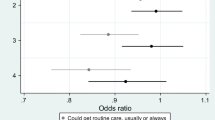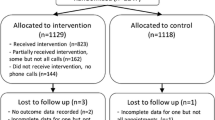Abstract
OBJECTIVE: Although the decision about how frequently to see outpatients has a direct impact on a provider’s workload and may impact health care costs, revisit intervals have rarely been a topic of investigation. To begin to understand what factors are correlated with this decision, we examined baseline data from a Department of Veterans Affairs (VA) Cooperative Study designed to evaluate telephone care.
DESIGN: Observational study based on extensive patient data collected during enrollment into the randomized trial. Providers were required to recommend a revisit interval (e.g., “return visit in 3 months”) for each patient before randomization, under the assumption that the patient would be receiving clinic visits as usual.
POPULATON/SETTING: Five hundred seventy-one patients over age 55 cared for by one of the 30 providers working in three VA general medical clinics. Patients for whom immediate follow-up (≤2 weeks) was recommended were excluded.
MEASUREMENTS: Mean revisit interval was adjusted for patient factors using a regression model that accounted for patients being nested within providers and providers being nested within sites. Four patient-level variable blocks (illness burden-patient, travel time, illness burden-physician, and prior utilization) were sequentially entered into a linear model to determine their role in explaining the variance in revisit intervals. Physician identity was also entered after four blocks.
MAIN RESULTS: Recommended revisit intervals ranged from 1 month to over 1 year with the most common recommended intervals being 2, 3, or 6 months. About 10% of the variance in revisit interval was explained by illness measures independent of provider (e.g., general health perception) and travel time. Adding other illness measures (e.g., diagnoses, medications) and prior utilization (e.g., clinic visits) doubled the variance explained (R 2=.21). Finally, the identification of individual provider doubled the explained variance again (R 2=.45). After adjusting for patient factors, the average revisit interval for individual providers ranged from 8 to 26 weeks (8 to 19 weeks when restricted to the 16 staff physicians). There were also substantial differences across the three sites (adjusted means: 14, 17, and 11 weeks).
CONCLUSIONS: Even after adjusting for a detailed array of patient-level data, primary care providers have different practice styles regarding the timing of return visits. These may, in turn, reflect the local “culture” in which they practice. How many patients providers are able to care for may be determined by the providers’ inclinations toward the timing of follow-up visits.
Similar content being viewed by others
References
Gordon GH, Webb DW. Effect of psychosocial factors on medical outpatient return visit intervals. Clin Res. 1984;32:31A. Abstract.
Gordon GH, Tyler J, Friis R. Factors influencing return visit intervals in a medical outpatient clinic. Clin Res. 1984;32:32A. Abstract.
Dittus RS, Tierney WM. Scheduling follow-up office visits: physician variability. Clin Res. 1987;738A. Abstract.
Stern MF, Fitzgerald JF, Dittus RS, Tierney WM, Overhage JM. Office visits and outcomes of care: does frequency matter? Clin Res. 1991;39:610A. Abstract.
Alger DW. Appointment frequency versus treatment time. Am J Orthod Dentofacial Orthop. 1988;94:436–9.
Boggs DG, Schork MA. Determination of optimal time lapse for recall of patients in an incremental dental care program. J Am Dent Assoc. 1975;90:644–53.
Wang NJ, Riordan PJ. Recall intervals, dental hygienists and quality in child dental care. Commun Dent Oral Epidemiol. 1995;23:8–14.
Wang NJ, Holst D. Individualizing recall intervals in child dental care. Commun Dent Oral Epidemiol. 1995;23:1–7.
Kent DL, Nease RA, Sox HC, Shortliffe LD, Shachter R, The Bladder Cancer Follow-up Group. Evaluation of nonlinear optimization for scheduling of follow-up cystoscopies to detect recurrent bladder cancer. Med Decis Making. 1991;11:240–8.
Fihn SD, McDonell MB, Vermes D, et al. A computerized intervention to improve timing of outpatient follow-up: a multicenter randomized trial in patients treated with Warfarin. J Gen Intern Med. 1994;9:131–9.
Lichtenstein MJ, Steele MA, Hoehn TP, Bulpitt CJ, Coles EC. Visit frequency for essential hypertension: observed associations. J Fam Pract. 1989;28:667–72.
Parchman ML, Bisonni RS, Lawler FH. Hypertension management: relationship between visit interval and control. Fam Pract Res J. 1993;13:225–31.
Lichtenstein MJ, Sweetnam PM, Elwood PC. Visit frequency for controlled essential hypertension: general practitioners’ opinions. J Fam Pract. 1986;23:331–6.
Tobacman JK, Zeitler RR, Cilursu AM, Mori M. Variation in physician opinion about scheduling of return visits for common ambulatory care conditions. J Gen Intern Med. 1992;7:312–6.
Wasson J, Gaudette C, Whaley F, Sauvigne A, Baribeau P, Welch HG. Telephone care as a substitute for routine clinic follow-up. JAMA. 1992;267:1788–93.
Ware JE. SF-36 Physical and Mental Health Summary Scales: A User’s Manual. Boston, Mass: The Health Institute, New England Medical Center; 1994.
Weinberger M, Oddone EZ, Henderson WG. Does increased access to primary care reduce hospital readmissions? N Engl J Med. 1996;334:1441–7.
Author information
Authors and Affiliations
Consortia
Additional information
The views expressed herein do not necessarily represent those of the Department of Veterans Affairs or the United States Government.
This study was supported by the Department of Veterans Affairs Cooperative Studies Program. Drs. Schwartz and Woloshin were supported by Veterans Affairs Career Development Awards in health services research and development.
Rights and permissions
About this article
Cite this article
Welch, H.G., Chapko, M.K., James, K.E. et al. The role of patients and providers in the timing of follow-up visits. J GEN INTERN MED 14, 223–229 (1999). https://doi.org/10.1046/j.1525-1497.1999.00321.x
Issue Date:
DOI: https://doi.org/10.1046/j.1525-1497.1999.00321.x




